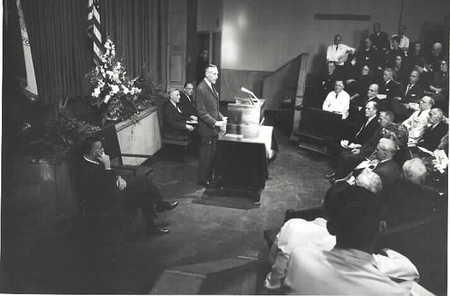Submitted by chh4011 on October 10, 2019 - 10:42am
As caricature evolved from its origins as a practice designed to liberate artists from the constraints of Renaissance Idealism into a tool for social satire and commentary, medicine emerged quickly as one of its favorite topics. This talk will turn to the obsessive interest in medicine on the part of 17th- and 18th-century caricature as a way of exploring the development of a uniquely rich and unlikely interrelationship on the eve of modern medicine and the emergence of cartooning in its modern form.
Submitted by chh4011 on August 1, 2019 - 2:23pm
Indian inventor, mentor, and researcher Dr. Brij Saxena was a pioneer in the field of reproductive endocrinology. In 1966, he was recruited by Nobel Laureate Dr. Vincent du Vigneaud to join Cornell University Medical College (now Weill Cornell Medicine) as an associate professor. Dr. Saxena’s research included the isolation of the lutropin receptor, which contributed to the development of ovulation detection and the first reliable early home pregnancy test in 1978. Among other research efforts, in the new millennium, Dr.
Submitted by chh4011 on June 5, 2019 - 2:07pm
Nobel Laureate Dr. Vincent du Vigneaud pioneered research in oxytocin during his long career at Cornell University Medical College (now Weill Cornell Medicine.) Oxytocin, a polypeptide hormone, is responsible for social bonding during sex, childbirth, and breastfeeding. It also produces breast milk and the contractions of the uterus during labor. Dr. du Vigneaud was awarded a Nobel Prize in Chemistry for landmark research in sulfur compounds and the first synthesis of oxytocin in 1955. His work opened new research in the field of protein organic chemistry.
Submitted by chh4011 on May 10, 2019 - 3:13pm
Scottish scientist John MacLeod was a leading expert in male infertility and the behavior of the human spermatozoa. In 1938 he received an offer to head the male infertility clinic at Cornell University Medical College (now Weill Cornell Medicine), and later became a professor of cell biology and anatomy.
Submitted by chh4011 on October 3, 2017 - 9:29am
In 1916, the American Red Cross prepared for US possible involvement in the war by organizing base hospitals. The Red Cross identified several major medical centers or hospitals to organize these units. The idea was that the doctors and nurses would already work well together. Each medical center or hospital supplied the personnel, equipment, and supplies for their unit. Twenty two doctors, 2 dentists, 65 Red Cross nurses, 22 nurses’ aides, 153 enlisted men, 6 civilians, and chaplain staffed each base hospital for a two-year service.
Submitted by chh4011 on January 23, 2017 - 9:42am
We Heard the Call: Our Doctors and Nurses in World War I exhibit celebrates the 100th anniversary of our doctors and nurses affiliated with The New York Hospital, Cornell University Medical College, and New York Hospital Training School for Nurses service in World War I. 417 (260 were CUMC alumni) doctors, 201 nurses, and 29 Bloomingdale Hospital employees answered the call to serve in the war.
Submitted by chh4011 on June 25, 2014 - 10:27am
The photograph above shows a nursing student receiving clinical training from a nurse at New York Hospital (now NewYork-Presbyterian Hospital) in 1967.
Submitted by chh4011 on June 4, 2014 - 5:22am
Submitted by chh4011 on February 1, 2013 - 8:32am
At the dawn of the Civil War, New York Hospital was located at its first site on Broadway between Duane and Worth Streets. From April 1861-February 1862, New York Hospital had an agreement with the New York State Militia to accept sick or wounded officers and privates. From February 1862 until the end of the war, the hospital had an agreement with the U. S. Medical Department to accept non-commissioned officers and privates from the Union Army.
Submitted by chh4011 on November 16, 2012 - 4:20am

The Samuel J. Wood Library and Research Building was dedicated on October 17, 1962. The new building included research laboratory space, new lobby for the medical college, and the medical college library. Enjoy some pictures of our library below.



